Cognition Unit #3
1/173
There's no tags or description
Looks like no tags are added yet.
Name | Mastery | Learn | Test | Matching | Spaced |
|---|
No study sessions yet.
174 Terms
Unfocused Thinking and Problem Solving
Refers to a lack of concentration or attention, resulting in scattered thoughts or distractions.
What is an example of unfocused thinking?
Daydreaming or being easily distracted during tasks.
Focused Thinking and Problem Solving
How to get from point A to point B. More goal-directed.
What is an example of focused thinking?
Strategically planning steps to complete a project or solve a math problem.
What are the features of a problem?
The initial state
The goal state
Operators
Constraints
What describes this feature of a problem: Initial state
The givens. The things that are true at the start.
What describes this feature of a problem: The goal state
What you want to achieve.
What describes this feature of a problem: Operators
Actions that can change your state—some ways of changing the initial state to the goal state. More unclear!
What describes this feature of a problem: Constraints
The obstacles preclude an obvious means of achieving the goal state. More unclear!
What is a problem?
There is a goal to be reached, but the solution is not immediately obvious.
What is thinking?
Going beyond the information given to reach a goal (e.g. a solution, a decision, or a belief).
What we do when we don't know how to act or what to believe or desire.
A complex skill that fills up gaps in the evidence.
Well-Defined Problems
Initial states, goals and means of transforming conditions are clearly specified. Easily generate a solution or plan in problem-solving.
Ill-defined Problems
Problem features are not completely specified. Figure out information/actions that are unavailable to you.
True or False: Well-defined problems are more interesting to study.
False. Researchers are more interested in the process in-between when solving ill-defined problems because they may suffer from retrospection or biases when trying to recall out loud/think-aloud, descriptions that may differ from one person to another.
What are the methodological challenges associated with problem-solving research?
1. Complexity – involves many different cognitive processes
2. Timing. The time it takes to solve the problem varies. Reaction time and accuracy are not the best things to answer.
3. Not enough information to support the solution you arrived at. What information do you need?
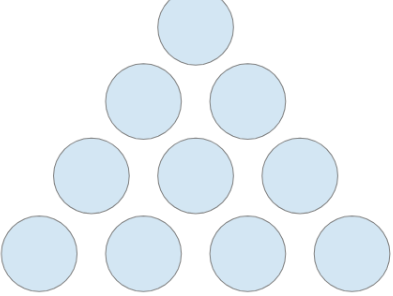
True or False: You are given a problem where you need to move 3 circles to make the given pyramid upside down. Therefore, this is an ill-defined problem.
False. This problem has a clear initial state and a goal state where the directions are clear because you are given steps to reach the goal state.
True or false: Between accuracy and response time, accuracy measures how well a person’s problem-solving methods.
False. Neither are good measurements because response times varies and most people will arrive at the solution.
True or False: GPS (General Problem Solver) can solve math problems.
True. Has a “problem space”.
True or False: The GPS cannot be used for ill-defined problems.
True. Runs into problems when it comes to complex goals and inattentional demands.
True or False: Researchers care about the initial and goal states of problem-solving methods in people.
False. It is more important to know the steps in between on how the person arrived from the initial state to the goal state.
What is an algorithm?
Rules applied systematically to problems that guarantee a correct solution, if one exists.
True or False: An example using algorithm to solve problems is determining the hypotenuse of a triangle.
True. Guaranteed solution.
What is a heuristic?
A general rule that usually yields a correct answer. Convenient rules of thumb.
True or False: Heuristics can be used to solve anagrams MORE quickly than algorithms.
CILRLYA → LYRICAL
True. Algorithm methods may be more inefficient despite always producing the correct solution because instead of going through all the combinations, you can pick out the most common letter combinations.
What is a problem space?
A mental representation of the initial state, the goal state and all the possible steps – or subgoals - in between them.
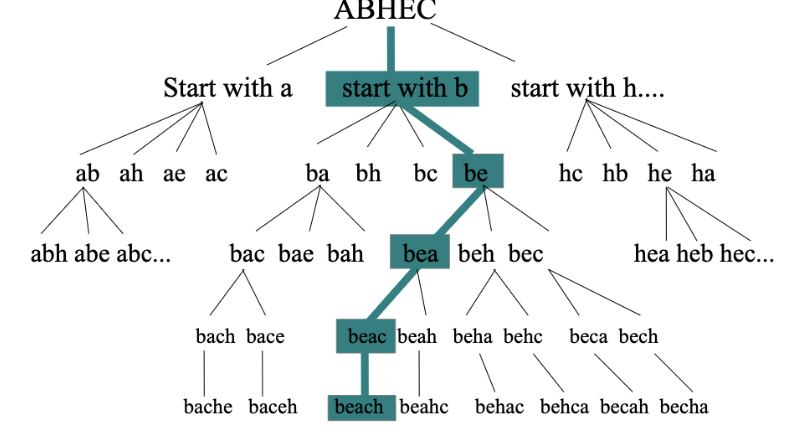
True or False: This diagram does NOT demonstrate the ‘problem space’ for the anagram, ABHEC.
False. There are 120 combinations.
True or False: When solving problems that involve multiple combinations, the use of an algorithm is NOT practical and possible.
True. The general rule of using heuristics for problems like these is creating shortcuts through the ‘problem space’, using pre-existing knowledge, AND being quickly efficient.
True or False: A person solving this anagram, LSSTNEUIAMYOUL, using the heuristic method is prone to mistakes.
True. Heuristics can lead to errors.
What describe the hill climbing heuristic?
At every opportunity, make the choice that seems to move you in the direction of your goal.
True or False: Drawbacks of the hill-climbing heuristic involves the tendency to MOVE backwards because they are taking the time to go through the sub-goals to achieve their goal state.
False. People often rely on this heuristic because you are moving toward that goal.
True or False: Losing weight is NOT an example of hill-climbing heuristic because it focuses on the long-term goals where people tend to know that losing weights come with setbacks.
False. Good strategy for short-term goals but not long-term goals because in short-term, people will likely feel lost, so they stop losing weight which demonstrates the failure in this heuristic even if the steps you are taking are correct.
What describes the means-ends heuristic?
Reducing differences between initial state and goal state by dividing the problem into subgoals UNTIL the difference between initial state and goal state is zero.
True or False: The GPS is NOT an example of the means-end heuristic.
False. In GPS, you are identifying smaller milestones and gradually, it will move you toward the goal.
True or False: NU pathways are examples of the means-end heuristic because completing an NU degree requires fulfilling these pathways, representing BIGGER milestones.
False. Completing a goal requires completing subgoals which is the definition of this heuristic.
What describes the working backwards heuristic?
Starting at the goal state like starting at the end of the maze.
True or False: In general, people use working backwards often.
False. People feel like this is counterintuitive, but this helps you define the optimal pathway because it is helpful when it reveals the subgoals necessary to achieve it.
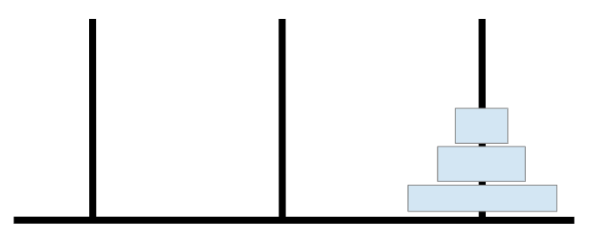
True or False: The Tower of Hanoi requires ALL the heuristics to IDEALLY solve the problem.
True. The initial state and the goal state are defined.
What describes the reasoning by analogy heuristic?
This heuristic looks for similarities between current problems and one solved in the past.
Tumor/General Problem - Are people good at using problems they solved in the past to solve harder problems despite both problems having the same underlying structures?
Situation: The patient has a tumor in a location that makes it inoperable. vs. Rebel general amasses a huge army to destroy a dictator.
Problem: One huge beam can destroy the surrounding healthy tissues of the cancerous one vs. Large forces can set off booby traps.
Solution: Combined smaller rays are intense enough to destroy the tumor without damage to healthy tissues vs. Smaller divisions meet at the fortress simultaneously to overtake the dictator and his army.
Experiment of Gick and Holyoak, 1980
Only 10% of participants solved the tumor problem when it was presented by itself
Only 30% spontaneously noticed the analogy when presented with both problems–most people failed the general problem.
75% could solve the tumor problem when the analogy with the general story was explicitly pointed out–suggests they cannot solve problems spontaneously when the surface features do not match the underlying features.
Results of Gick and Holyoak, 1980
The use of the analogy improved performance from 10% to 75% success. Participants needed a lot of help to make use of the analogy. Why? People tend to miss underlying similarities when surface features are different. People do not spontaneously see that, but prompting can help them see the similarities between the two. Therefore, analogy can help solve these problems.
Implications of experiment for Gick and Holyoak, 1980
Method: Experts categorized problems based on deep structural principles, while novices used surface features.
Results: Expertise involves recognizing underlying conceptual frameworks rather than surface similarities.
Conclusion: Therefore, experts were better able to categorize, suggesting that background knowledge can help you see and cut through surface stuff and see underlying knowledge.
Expert problem solvers vs. lazy problem solvers - Chi, Feltovich & Glaser (1981)
Expertise and problem-solving - What are the differences between ordinary problem-solvers and experts?
Result: Participants with more math expertise (high quant SATs) are more likely to use an analogy when solving algebra problems (using previous knowledge). No relation to verbal SATs suggests the effect depends on expertise in the relevant domain.
Analysis: Suggests that analogies of what you know cannot extend to other domains. Analogies are domain-specific and not domain-general, so you need more context for that domain.
Therefore, analogy is a powerful problem-solving strategy. Must look beyond the surface features of the problem to its underlying structure.
The use of analogy - Novick and Holyoak, 1991
What are the problems with algorithm problem solving?
Most real-life problems have too many potential paths to the goal whereas algorithms are too practical.
What are examples of heuristics?
Hill-climbing, means ends, reasoning by analogy, and working backwards.
True or False: Reasoning by analogy is best used for more complex problems.
True. Analogies are underused and require instructions or contexts that encourage attention to a problem's deeper structure instead of its surface features.
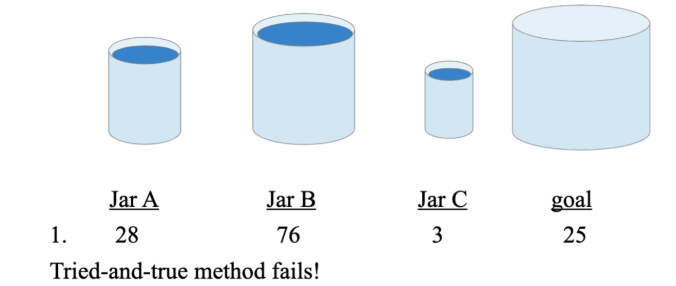
Analogical approach is always the right way to do this. Making it more complex but the solution is more simple and using this approach can lead you to making mistakes.
What can get in the way of problem solving? - Water Jar.
Approach becomes automatic that it leads you to miss other stuff. A tendency to adopt a certain approach or strategy to solving a problem which makes it difficult to consider other plausible procedures.
Mental Set (Luchins, 1942)
A mental set about an object: The tendency to view objects inflexibly - only in terms of their typical functions. “A mental block against using an object in a new way that is required to solve a problem”.
Functional fixedness (Duncker, 1945)
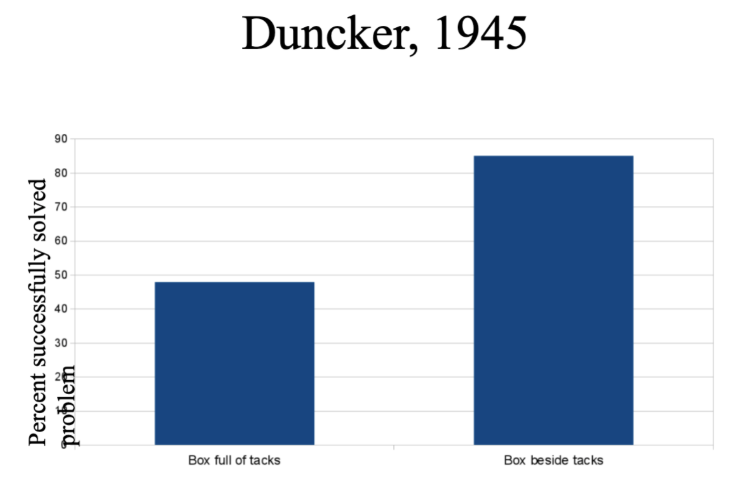
Goal: Participants needed to attach a candle to the wall.
Result: People were using thumbtacks. BUT, you were meant to use the box with thumb tacks and put the candle in the box while the box had a thumb tack to put onto the wall. When participants were given a box of tacks, it increased functional fixedness. The box full of tacks encouraged rigid thinking about the box—as just a container for the tacks.
Analysis: If the thumbtacks were in the box, people think of the box as a thumb tack holder, leading them to have a fixed mindset. But, if the items were presented separately, they are likely to solve the problem.
What can get in the way of problem solving? - The candle problem
Experiment: How can you tie the string with a hammer? How many different uses are there for a hammer? How about as a pendulum weight?
Result: People do not see hammers as a pendulum weight. Most people think objects as their functions, but it creates this barrier in novel situations where you can use it in a different way.
Analysis: Mental set - hinders problem-solving when it blinds you alternative approaches. But is mental set always a bad thing? Constrains the range of solutions you consider–can be helpful...
What can get in the way of problem solving? - The string problem
True or False. Creative solutions are novel AND are appropriate.
True. A product of special or regular, everyday cognition?
Time spent wrestling with a problem.
What is the Preparation stage of Creativity? - Wallas (1926)
Time spent away during which problem solving continues unconsciously.
What is the Incubation stage of Creativity? - Wallas (1926)
Insight – a new idea suddenly emerges.
What is the Illumination stage of Creativity? - Wallas (1926)
Will the solution actually work?
What is the Verification stage of Creativity? - Wallas (1926)
True or False: Preparation and Verification are more helpful in creative processes.
False. Incubation and Illumination are more important in bringing up novel ideas.
Experiment: Picture/word puzzles (rebuses). Incubation and insight – what's going on? Clues were given – often misleading ones.
Split timing (ti ming)
Searching above and bottom
oholene (hole in one)
Participants either: Worked on the puzzles continuously. Took a break and did nothing or took a break and had some intervening task.
Questions: How likely are they going to solve the problems? The one who took a break and did something else, or the people with no break?
Results: The “incubation” group (that took a break and did something else) was more likely to come up with the solution. Smith & Blankenship tested memory for misleading clues. Incubation participants were less likely to remember the clues. Eliminated freedom from a mental set because they would not fixate their guesses.
Conclusions: Forgetting misleading clues and dropping your solutions can help you come up with something new. This is a form of retroactive interference. Therefore, creative solutions entail generating time and distance from the original approach will help you come up with something new.
Insight and the moment of illumination “Aha!” - Smith and Blankenship (1989, 1991)
What is divergent thinking?
A creative problem-solving approach that involves generating multiple, often unconventional, ideas and solutions to a problem, exploring various possibilities, and thinking "outside the box"
How can you quantify divergent thinking?
Originality
Fluency
Flexibility
Elaboration
Originality
Uses produced different from the norm.
Fluency
The total number of uses produced.
Flexibility
Number of different types (or categories) of uses.
Elaboration
Detailed explanations of uses (What will look like?)
Reasoning
The process of drawing conclusions from given information–deductive and inductive use different information and draw different conclusions.
True or False: This is a valid example of reasoning - All A's are B's. All C's are A's. Therefore, all C's are B's.
True
Inductive Reasoning
Reasoning about conclusions that are likely given some set of premises (specific —> general).
Deductive Reasoning
Drawing conclusions from a set of premises using principles of logic (general —> specific).
True or False: “All dogs chase their tails. Bob is a dog. Therefore, Bob chases his tail.” This example uses inductive reasoning.
False. Conclusions have deductive validity–if premises are true and reasoning proceeds according to logical rules, the conclusion cannot be false. Does not have to be practically true. Depends on what information you start with. Come with a conclusion that is accurate in the structure of why.
True or False: “Robins lay eggs. Blue jays lay eggs. Therefore, all birds lay eggs.” This example uses inductive reasoning.
True. Deals with probable truth. Has inductive strength—a strong argument is one in which the truth of the premises increases confidence in the conclusion (rather than the rules itself). Evaluating how good of a conclusion is based on information you start with.
Syllogism
A type of logical argument that contains two or more premises, completed with a conclusion that may or may not follow from the premises.
True or False: 81% of participants believed this conclusion was valid - “All A’s are B’s. All B’s are C’s. Therefore, all A’s are C’s.
True. Demonstrates how people are bad at these deductive rules and how people are remarkably bad at reasoning about syllogisms.
Why does Syllogism fail?
“Some psychology majors are friendly people. Some friendly people like dogs. Therefore, some psychology majors like dogs.”
Result: ‘Some’ makes it seem like it is true.
Conclusion: Logically they do not have to match up. People are not using logical rules to evaluate these arguments even if they are correct. Therefore, they are using their own pre-existing beliefs to evaluate these statements.
Influence of Abstract Information on ‘Syllogism’ Reasoning
Deals with symbolic or generalized concepts. Often used in logic and mathematics. Can be difficult for people to intuitively grasp, leading to more errors in reasoning due to a lack of real-world context.
Influence of Meaningful (Concrete) Information on ‘Syllogism’ Reasoning
Uses real-world knowledge and familiar concepts. Easier for people to process and accept, especially when prior knowledge aligns with the conclusion. However, belief bias can occur.
Belief bias
People may accept an invalid syllogism if the conclusion aligns with their existing beliefs.
True or False: According to belief bias, this is a valid syllogism, “All mammals lay eggs. A dog is a mammal. Therefore, a dog lays eggs”.
True. The general reasoning is a false major premise. so, this syllogism is logical but incorrect in reality.
True or False: According to belief bias, this is a valid syllogism, “All dogs are pets. Some pets are cats. Therefore, some dogs are cats”.
False. It is seemingly reasonable, but invalid.
Conditional Reasoning
Logical reasoning involving "If P, then Q" statements.
Structure of Conditional Reasoning
Requires the Antecedent (P) which is the condition. Then, the Consequent (Q) which the result.
True or False: In the example, “If a student is taking Cognition, then she must have completed Intro Psych”, the student taking Cognition is the consequent.
False. The proposition that comes first, following if; the condition, so it is the Antecedent.
True or False: Affirming the Antecedent and Denying the Consequent are VALID inferences.
True. If P, then Q. P is true, so Q is true. If P, then Q. Q is false, so P is false.
True or False: Affirming the Consequent and Denying the Antecedent are VALID inferences.
False. These are invalid: 1.) If P, then Q. Q is true, so P must be true. 2.) If P, then Q. P is false, so Q must be false.
True or False: This is a valid statement, “If Julie is a psychology major, then she is a student Julie is not a student. Therefore, Julie is not a psychology major.”
True. You are denying the consequent.
True or False: This is a valid statement, “If today is Thursday, then I have my pottery class. I have my pottery class. Therefore, today is Thursday.”
False. You are affirming the consequent.
True or False: In general, people have difficulties reasoning with meaningful (concrete) information.
False. People are much better at conditional reasoning when content is meaningful. while people are bad at using abstract logical rules because no one is good at deducting bottom-up information rather than top-down information.
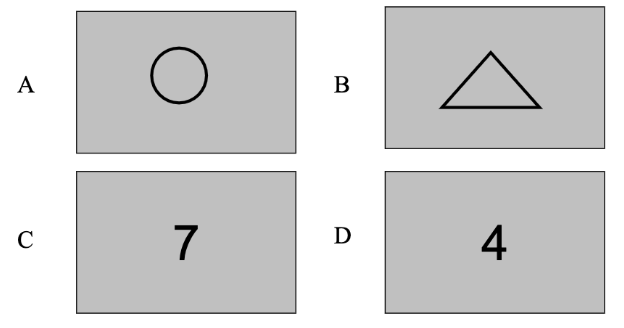
Experiment - Conditional Reasoning
Method: If a card has a circle on one side, then it must have an even number on the other. The participant would choose what card to flip over to evaluate if it is following the rules.
Result: A and C are valid cards to choose. However, people want to flip over D. They want to affirm the consequent which does not validate the rule. Only 4% of people get this right! People assume the conditional is bidirectional. If there's a circle there must be an even number ≠ If there's an even number, there must be a circle.
Conclusion: According to one’s confirmation bias, people try to confirm a hypothesis rather than disprove it. Assuming circles and even numbers go together, then find evidence. Therefore, they are likely to affirm the consequent.
Wason Card Selection Task
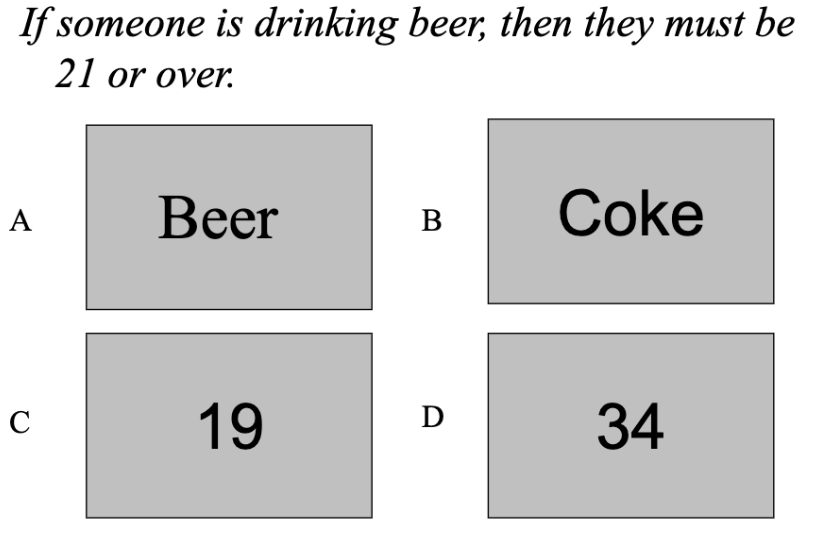
True or False: Background experience with the rule in practical terms, allows you to complete the logical reasoning of the problem rather than things with zero familiarity.
True. College students have familiarity with drinking rules, so being familiar with the rules allows you to have better reasoning (meaningful information).
Confirmation bias
Rather than strictly adhering to the rules of logic, we are easily swayed by our beliefs and actively seek to confirm what we believe to be true.
Inductive strength
Premises provide stronger or weaker support for conclusion. Making a good estimated guess. How much can you trust the information?
Methods: If one of these is a stronger example of inductive reasoning, which one would it be?
1. Robins have ileated bones. Therefore, all birds have ileated bones.
2. Turkeys have ileated bones. Therefore, all birds have ileated bones.
Results: Not a lot of birds like turkeys. So people are more likely to say that all birds have ileated bones based on the robin’s ileated bones.
Conclusion: Demonstrated having a typicality effect in inductive reasoning (robins > turkeys).
Rips (1974)
Typicality Effects on Inductive Strength
The more typical the premise category, the stronger the inference to an inclusive category.
Methods:
Hawks have digestive enzyme Y.
Robins have digestive enzyme Y.
Therefore, all birds have digestive enzyme Y.
Sparrows have digestive enzyme Y.
Robins have digestive enzyme Y.
Therefore, all birds have digestive enzyme Y.
Results: Want a broader spectrum of birds to get more coverage to get a diversity of birds. People chose the first argument.
Conclusion: Diverse argument is stronger when you keep adding things. Therefore, the more diversity and premise categories that differ from each other, then the stronger the inference.
Diversity (Rips 1974) - Which one has a stronger effect in inductive reasoning?
Experiment: Participants given a number series (ex. 2, 4, 6) that conforms to a rule. Participants must discover the rule by offering their own number series (experimenter answers, “yes that follows the rule” or “no that doesn't follow the rule”).
Method: So, given 2, 4, 6: What's the rule? – A set of numbers that are increasing.
Results: Participants had difficulty discovering the relatively simple rule (numbers that increase) because they tended only to try to confirm their hypotheses rather than finding rules that opposes the rule (which is probably more powerful because they are violating their sets of beliefs).
Confirmation bias in inductive reasoning - Wason (1966, 1968)
Method: Participants asked to conduct interviews to determine interviewee's personality traits. Led to expect either an extrovert or an introvert. Given a set of questions to select from to figure out if the interviewer is an extrovert or an introvert:
½ framed for extroversion (“what would you do to liven up a party?”)
½ framed for introversion (“what do you dislike about loud parties?”)
Results: Participants tended to choose questions from the list that served to confirm their beliefs about the interviewee.
Conclusion: Ask all introvert questions to see if there is zero contradictory rather than confirming beliefs by gaining more examples that align with those beliefs. Want to be asking questions that opposes to what you already believe in or what you already know.
Confirmation bias in inductive reasoning - Snyder & Swann (1978)
True or False: Humans are logical.
False. We are predictable in our patterns because our confirmation bias hinders our reasoning and humans have the tendency to reason most effectively on problems whose content we have experience with.
Judgement
Judgment: The human ability to infer based on limited information, estimate, and predict the character of unknown events.
Decision-making
Generating, evaluating, and selecting among a set of relevant choices, where the choices involve some uncertainty or risk.
True or False: It is a good thing to study errors in JDM research because heuristics usually allow us to NOT make the best decisions we can given processing limitations and limited information.
False. They are mental short cuts.
True or False: It is a good thing to study errors in JDM research because knowing what heuristics we use can actually help you make sure you're using them properly and not being led astray.
True. They are efficient.